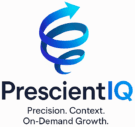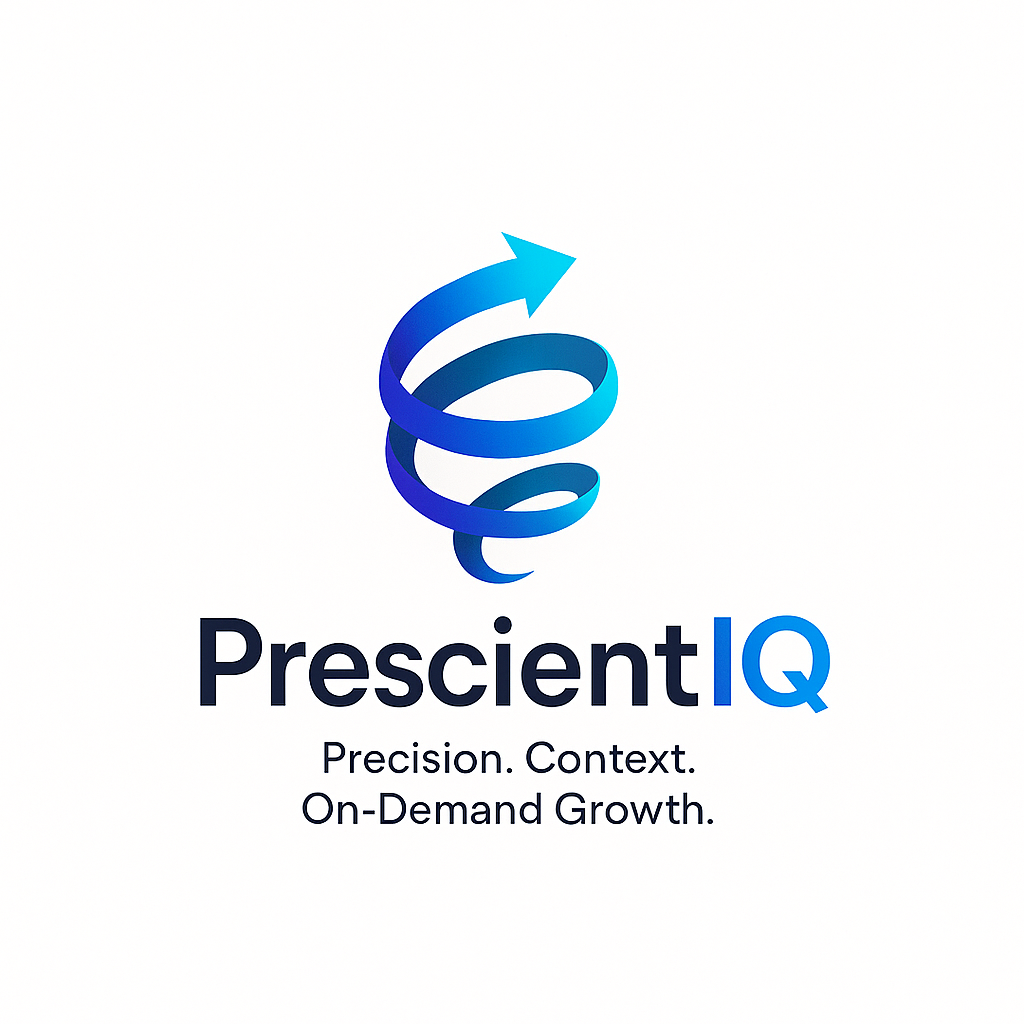The Agentic Shift in Sales and Marketing — Measuring and Forecasting AI ROI with Aether by PrescientIQ
Learn About The Agentic Shift in Sales and Marketing — Measuring and Forecasting AI ROI with Aether by PrescientIQ.
Sara oversees revenue growth for a large global manufacturing firm.
She’s responsible for both sales and marketing operations across multiple regions, product lines, and customer segments. In recent years, she’s driven improvements via digital tools: better CRM analytics, marketing automation, predictive lead scoring. But despite all that, growth is plateauing.
The cost per lead keeps creeping up, the sales cycle is stubbornly long, and competitors with agile digital models are gaining ground.
Her executives are asking: “If we’re investing so much in digital tools, why aren’t we getting ahead?” Meanwhile, she sees other firms talking about advanced AI, “autonomous agents,” and new models of sales & marketing — but she’s unsure how to capture that value responsibly and measurably before committing big budget.
The Turning Point: From Tools to Teams
Sara comes across a senior leadership briefing that highlights a shift: AI in sales/marketing is not just about optimizing existing workflows (reduce costs, shorten cycles), but about autonomous orchestration — AI systems operating as teams of agents (the article calls it the “agentic shift”). AI Marketing That Thinks Ahead.
She realises: If I don’t move from “AI as a tool” to “AI as a teammate/agent network,” I risk being overtaken. The article frames it this way: moving from “humans using AI tools” to “humans leading AI teams.”
That triggered her sense of urgency: what if a competitor deploys agentic systems first, delivers autonomous lead gen, autonomous campaign creation, autonomous sales outreach, and she’s still stuck at “help the human do better”? The risk is not just missing growth — it’s being left behind.
Enter Aether: Forecasting Before You Leap
In her research, Sara finds the Aether platform by PrescientIQ, which promises to forecast AI ROI before implementation. The article explains that Aether helps leaders calculate the “autonomy delta” — the difference between traditional human-augmented ROI and fully agentic ROI.
What caught Sara’s attention:
- Instead of waiting months post-deployment to see whether AI delivered value, Aether offers simulation first: ingest historical data, simulate agentic systems, forecast output, cost, risk.
- It reframes value: not just “time saved” or “cost per lead reduced,” but “output generated by AI agents,” “autonomous leads per compute dollar.”
- It aligns with her board’s language: predicted ROI, payback period, risk-adjusted. She can speak CFO/CEO language rather than just tech-buzz.
Recognising the FOMO risk (if she waits, others will move ahead), she decides: we’ll pilot Aether to assess whether moving toward agentic systems makes sense for her organization.
The Simulation & Early Results
Sara launches a pilot. She works with Aether to ingest historical marketing & sales data from one product line and region. The simulation uncovers startling possibilities:
- What if the marketing agent could generate 4× the number of campaigns in the same period versus human-led teams? (The article uses an example of 10 campaigns/month → 40 campaigns/month).
- What if the compute/licensing cost of the agentic system is significantly lower than adding more headcount or scaling human workflows?
- What if by modelling risk via governance, compliance, and data quality, she could show a board a risk-adjusted ROI pre-deployment?
Sara produces a presentation: “If we adopt agentic systems for Q4 in this region, we project X leads, Y incremental revenue, payback in Z months.” With Aether, she turns AI from an experiment into an investable asset class.
Her board listens. They see the FOMO: competitor firms are talking about AI, and they worry about being left behind. Sara’s language shifts from we might try AI optimization to we will orchestrate autonomous agentic systems that will redefine how we do sales & marketing.
Introduction: From Tools to Teams | Forecasting AI ROI

For the past half-decade, executives have measured AI success by one central question: What’s the return on our investment?
That question—quantified in marketing efficiency, customer acquisition cost (CAC), or sales cycle reduction—has been the cornerstone of AI strategy. It brought discipline and structure to innovation.
Yet, as technology matures, that same question risks becoming a trap.
The next phase of artificial intelligence in business is not about optimization. It’s about orchestration.
AI is evolving from a passive assistant to an active agentic system—a network of specialized, autonomous agents that collaborate with humans to achieve complex business outcomes. We are witnessing a shift from “humans using AI tools” to “humans leading AI teams.”
This evolution demands a radical rethink of leadership.
Beyond governance and ethics, leaders must learn to forecast AI performance before implementation and measure its return not just in productivity, but in autonomous value creation. It’s a new playbook for the C-suite—one grounded in foresight, not just hindsight.
Redefine Value: From Efficiency to Autonomy
ROI must evolve from “time saved” to “autonomous value created.” Agentic systems redefine productivity as an outcome rather than an input—multiplying functions without human dependency.
Outcome over input
Leaders should assess not only how AI improves processes, but how it can independently replace or multiply functions across the org.
Old → New
Quick framing
A simple way to think about it:
Autonomy ROI ≈ Agent-generated value ÷ Compute & orchestration cost
Track it as a product metric—not just an ops metric.
Section 1: The Current State — AI as a Transactional Optimizer
Today’s best-in-class AI systems are largely transactional optimizers.
They enhance human productivity within clearly defined boundaries.
In Marketing and Forecasting AI ROI
- AI personalizes content and recommendations in real time.
- It predicts churn, optimizes ad spend, and prioritizes leads based on behavioral scoring.
In Sales and Forecasting AI ROI
- AI enriches CRM systems, automates follow-ups, and suggests next-best actions.
- It compresses sales cycles and increases conversion velocity.
The metrics of success—Reduced CAC, increased LTV, shorter sales cycles, and fewer person-hours—are tangible and measurable. But they all share one trait: they assess AI as an efficiency enhancer, not as a strategic contributor.
This model works—until it doesn’t.
Optimization has diminishing returns. Once every process is faster, cheaper, and smoother, where does growth come from? The answer lies beyond automation—in the creation of autonomous systems that don’t just assist but act.
How Aether De-Risks Enterprise AI Adoption
Speed to Value
From 9-Month PoC to 14-Day Validation. Our Simulation-First motion delivers quantifiable insights in < 14 business days, crushing the traditional time-to-value.
Quantifiable ROI
Know Your ROI Before You Buy. Aether provides a non-binding, good-faith estimate of your specific cost savings and efficiency gains, turning a budget gamble into a predictable business case.
Uncompromising Security
Enterprise-Grade Data Governance. Your data remains your property. It is never used for training, is isolated in a single-tenant sandbox, and is permanently purged post-simulation.
See your future, first.
Section 2: The Agentic Shift — From Optimization to Autonomy
The emerging paradigm redefines AI as an agentic system: a network of autonomous digital agents working collaboratively toward enterprise goals.
From Tool to Team
In this model, an AI doesn’t just respond to human instructions—it coordinates with other AIs and humans to achieve outcomes.
Consider this future scenario:
A Chief Marketing Officer (CMO) issues a single directive:
“Launch a Q4 lead-generation campaign for our new enterprise finance product.”
Today, that request triggers a flurry of human-led tasks across departments. Tomorrow, an Orchestrator Agent will deconstruct this goal into subtasks:
- A Research Agent identifies emerging market trends, such as AIPlanPad.
- A Creative Agent generates campaign assets, such as AIContentPlan.
- A Finance Agent models ROI projections with Aether by PrescientIQ.
- A Compliance Agent ensures regulatory alignment.
- A Sales Agent aligns outreach sequences, lead scoring, and more with AICRMPad.
These agents collaborate autonomously, report back insights, and request human approval at key junctures. What emerges is not a dashboard—it’s a digital workforce.
This agentic system doesn’t just make humans faster; it multiplies output. It operates continuously, scales infinitely, and integrates intelligence across functions.
Section 3: Measuring AI ROI Before Execution

The challenge for leaders is no longer if AI will deliver value—it’s when and how much, before deploying it.
Pre-implementation ROI modeling is the new competitive advantage.
1. The Problem with Post-Hoc ROI
Traditional AI ROI is reactive.
It measures success after the system has been deployed—often months into operation. That’s too late for capital-intensive programs or AI-driven transformations where sunk costs are high.
Leaders need to forecast the financial and operational return before execution, enabling better prioritization, resource allocation, and risk management.
2. Pre-Deployment AI ROI Framework
To measure ROI before implementation, leaders must integrate three analytical lenses:
a. Capability Forecasting
Identify the specific tasks AI will augment or automate.
- What proportion of these tasks can AI perform autonomously?
- What are the potential performance gains in accuracy, speed, and scale?
Use historical performance data (e.g., human output rates, average task completion times) as baselines for simulation.
b. Cost Projection
Estimate total cost of ownership (TCO) across the AI lifecycle:
- Development/Integration: engineering, data labeling, and model training.
- Compute and Licensing: ongoing costs for inference, APIs, or hosting.
- Governance: costs of human oversight, compliance systems, and audits.
c. Value Modeling
Forecast expected outcomes—revenue uplift, reduced cycle times, or market share expansion.
Link them directly to organizational KPIs.
For instance, if an AI-driven marketing agent increases lead quality by 15% and conversion rates by 10%, this can be modeled as a direct increase in sales volume.
Formula:
AI ROI (Projected) = [(Incremental Gain × Probability of Success) – (Total Anticipated Cost)] / Total Anticipated Cost
This pre-execution metric transforms AI from an experiment into an investable asset class.
Section 4: Tools and Models for Forecasting AI ROI — The Role of Aether by PrescientIQ
Enter Aether by PrescientIQ, a new generation of AI ROI forecasting platform designed to bring financial-grade analytics to AI decision-making.
Aether is an AI portfolio intelligence system that enables organizations to predict, simulate, and monitor the financial and operational impact of AI initiatives before they go live.
Your Data-Driven Business Case in 14 Days
Step 1 — Ingest
Days 1–3You provide a historical data export (e.g., 100k records) via a secure, time-limited link.
Security: Data is encrypted at rest (AES-256) and in transit (TLS 1.2+).
Step 2 — Simulate PrescientIQ
Days 4–10Pre-trained AI models run a read-only simulation against your data in a private, sandboxed BigQuery dataset.
Security: Your data is never used for model training.
Step 3 — Analyze
Days 11–13We conduct a variance analysis comparing your historical outcomes to simulated AI-powered outcomes.
Step 4 — Deliver
Day 14We deliver the “Aether ROI & Efficiency Report” via an interactive dashboard and a 2-hour Executive Value Presentation.
You’re left with one thing: a confident, data-backed decision.
1. The Aether Framework
Aether’s methodology integrates three forecasting pillars:
a. Predictive Performance Modeling
Aether leverages historical datasets, domain-specific benchmarks, and advanced simulation models to estimate the likely productivity gains from AI agents.
It creates digital twins of processes—virtual replicas of sales funnels, marketing pipelines, or service workflows—to forecast how AI integration changes throughput, accuracy, and cost.
For example, a marketing automation process can be modeled with and without agentic AI:
- Current throughput: 10 campaigns/month
- Projected throughput with AI agents: 40 campaigns/month
- Expected improvement: +300% operational capacity
b. Economic Impact Simulation
Aether quantifies the financial value generated by these gains.
It maps predicted efficiencies to top-line and bottom-line outcomes, incorporating both direct (e.g., increased sales, reduced costs) and indirect (e.g., employee redeployment, customer retention) benefits.
The system uses Monte Carlo simulations and scenario sensitivity analysis to account for uncertainty.
Executives can test best-case, most-likely, and worst-case ROI scenarios before greenlighting an investment.
c. Governance-Integrated Risk Adjustment
Not all gains materialize evenly. Aether embeds a risk-weighted ROI model that adjusts forecasts based on compliance exposure, data quality, and system maturity.
For example:
- A new generative content model may offer 200% ROI potential but carry a 30% compliance risk factor.
- The adjusted forecast provides a more realistic investment outlook.
This ensures that AI ROI is not just optimistic—it’s accountable.
2. Measuring Agentic Value Creation
Traditional ROI stops at efficiency. Aether’s innovation lies in measuring autonomous output—the true hallmark of the agentic era.
a. From Time Saved to Output Generated
Instead of asking “How much faster did humans work?” Aether asks:
“How much value did the agentic system create autonomously, and what was its compute cost?”
This metric—Autonomous Productivity Yield (APY)—captures the ratio between autonomous output (e.g., campaigns generated, deals closed, models deployed) and computational input (e.g., GPU hours, API calls, or licensing fees).
b. AI as Digital Labor
Aether treats each AI agent as a digital employee with a measurable cost and output.
This allows leaders to benchmark the “salary-to-output ratio” of AI systems against human equivalents.
For instance:
- A sales AI team with a $50K annual compute cost autonomously generates $1.2M in qualified leads.
- APY = 24x return on computational labor.
This creates a new performance index: AI Workforce Productivity (AIWP), which can be tracked like any human KPI.
Section 5: C-Suite Imperatives for the Agentic Era
The emergence of agentic systems introduces three strategic imperatives for executives.
1. Redefine Value: From Efficiency to Autonomy
ROI must evolve from “time saved” to “autonomous value created.”
Leaders must assess not only how AI improves processes, but also how it can independently replace or multiply functions.
Agentic systems redefine productivity as an outcome rather than an input. Forecasting AI ROI is very important before you spend a cent.
Key Metric Evolution:
| Old Metric | New Metric |
| Time saved by humans | Output generated by AI agents |
| Reduced cost per lead | Autonomous leads created per compute dollar |
| Faster execution | Scalable execution without human dependency |
Aether helps leaders calculate this “autonomy delta”—the difference between traditional human-augmented ROI and fully agentic ROI.
2. Build Governance for Autonomy
When AI acts, transacts, and communicates autonomously, governance becomes existential.
Executives must establish Human-on-the-Loop (HOTL) systems where:
- Agents operate freely within defined constraints.
- They pause for human review at critical checkpoints (financial thresholds, ethical boundaries, or brand-sensitive communications).
Aether integrates governance modules that simulate the impact of policy settings. For example:
- Tight governance might reduce agent speed by 10% but improve risk-adjusted ROI by 25%.
This transforms governance from a compliance cost into a performance variable.
3. Reskill Talent: From Doers to Conductors
As AI agents take over execution, humans must transition into conductors—designing, managing, and optimizing digital workforces.
Emerging Roles:
- AI Orchestrators: Design and coordinate multi-agent ecosystems.
- Prompt Designers: Translate strategic goals into agentic tasks.
- AI Auditors: Continuously monitor agent behavior for bias, compliance, and performance.
- AI ROI Analysts: Use tools like Aether to simulate, measure, and refine return models in real time.
Reskilling programs should integrate technical literacy, strategic forecasting, and ethical decision-making.
Section 6: Case Study — Forecasting ROI Before Launch

A Fortune 500 B2B company used Aether to forecast ROI for deploying an autonomous marketing agent system.
Baseline:
- 8 human marketers, $1.6M annual operating cost
- 20 campaigns/quarter, $50K average revenue per campaign
Simulation Results (via Aether):
- Projected autonomous throughput: 80 campaigns/quarter
- Average campaign cost reduction: 60%
- Estimated compliance exposure: 5% (adjusted ROI factor applied)
Pre-Execution ROI Forecast:
- Predicted Revenue: $4M/quarter
- Total Cost (AI + Governance): $900K/quarter
- Projected ROI: 3.44x
- Payback Period: 2.8 months
Post-deployment results aligned within ±7% of the forecast—demonstrating Aether’s predictive accuracy and validating the power of pre-implementation modeling.
Section 7: The Strategic Role of Forecasting in the AI Economy
The ability to forecast AI ROI before implementation changes the economics of innovation. It moves AI from experimental spending to strategic capital allocation.
Organizations that adopt predictive ROI modeling will:
- Reduce wasted AI investment by up to 40%.
- Accelerate time-to-value by identifying high-impact use cases early.
- Build trust with boards and investors through financial-grade accountability.
Forecasting AI ROI is not just risk management—it’s leadership evolution.
Section 8: The Leadership Mandate — From Managing Tools to Leading Intelligence
The transformation from AI as a tool to AI as a teammate marks a profound leadership challenge. The metrics, governance models, and cultural dynamics of organizations must evolve to match.
New Leadership Competencies:
- Agentic Vision: Seeing AI not as software but as a workforce.
- Predictive Governance: Integrating risk-adjusted forecasting into decision-making.
- Digital Empathy: Understanding how human creativity and machine autonomy coexist.
- Adaptive Economics: Using models like Aether to measure and rebalance AI portfolios dynamically.
The companies that thrive will not be those with the most AI tools, but those with the most coherent AI leadership ecosystems—where humans and machines co-lead strategy, execution, and innovation.
Conclusion: Beyond Optimization, Toward Orchestration and Forecasting AI ROI
The first phase of AI was about dashboards. The next is about decisions.
The agentic shift marks the birth of a new digital workforce—one that requires governance, vision, and foresight. Measuring AI ROI after deployment is no longer sufficient. With predictive tools like Aether by PrescientIQ, leaders can now see before they act, quantify before they invest, and orchestrate before they execute.
The question for leaders is no longer “What is AI worth?”
It’s “How do we lead a workforce that thinks, learns, and acts at digital speed?”
The companies that master that answer will not just optimize processes—they’ll redefine the economics of intelligence itself.




